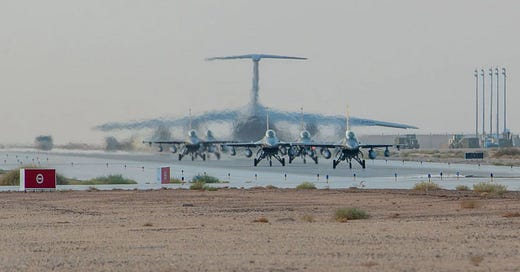U.S. Bolsters Military Presence Amid Israel-Iran Conflict
21 June 2025 | Frontline Veterans News
Air Force F-16C fighter jets with the 79th Expeditionary Fighter Squadron operate in the U.S. Central Command area of responsibility on May 29, 2025. Air Force photo by Senior Airman Kevin Dunkleberger.
The Post
As hostilities between Israel and Iran enter a second week, the United States continues to expand its military presence across the Middle East in what appears to be a sustained show of force and deterrence.
Currently, approximately 40,000 American troops are deployed in the region under U.S. Central Command (CENTCOM), which oversees operations in the Middle East, Egypt, and parts of Central Asia. The force includes a substantial naval fleet, advanced air defences, and ground units distributed across key strategic bases.
The U.S. has deployed two Terminal High Altitude Area Defense (THAAD) systems, one of its most advanced missile interceptors, alongside at least two Patriot missile batteries stationed in Iraq. American troops continue to operate out of 10 regional bases, including large installations in Bahrain, Kuwait, Qatar, and the United Arab Emirates. Additional positions are held in Jordan and Syria, while supporting infrastructure exists in Turkey and Djibouti.
Despite intelligence assessments from March indicating Iran is not actively pursuing nuclear weapons, U.S. officials have warned of potential military action, citing a need to prevent Tehran from achieving nuclear capability. The military build-up reflects a combination of deterrence against Iran and continued operations against Houthi forces in Yemen, which have engaged U.S. and allied targets in the region.
In Iraq, 2,500 troops remain as part of Operation Inherent Resolve, the ongoing mission to defeat ISIS. Roughly 1,500 troops are still stationed in Syria, although a gradual withdrawal has begun.
Naval deployments have increased significantly. The USS Carl Vinson Carrier Strike Group is currently operating in the Arabian Sea, supported by guided-missile cruisers and destroyers. The group carries Carrier Air Wing 2, with F/A-18E/F Super Hornets, F-35C stealth fighters, and E/A-18G Growlers for electronic warfare.
Three other destroyers, including the USS Thomas Hudner—which intercepted Houthi missiles in 2023—are stationed in the eastern Mediterranean. Two more destroyers operate independently in the Red Sea.
The USS Nimitz, originally scheduled to replace the Vinson, has had its deployment fast-tracked and will join the carrier in a rare overlap. This tactic, now routinely employed over the last 20 months, allows for rapid response options across CENTCOM’s area of responsibility.
In Bahrain, home to the U.S. Navy’s 5th Fleet, four mine countermeasure vessels support maritime security. This growing deployment underscores America’s intent to safeguard regional stability and respond swiftly to emerging threats amid escalating tensions.





